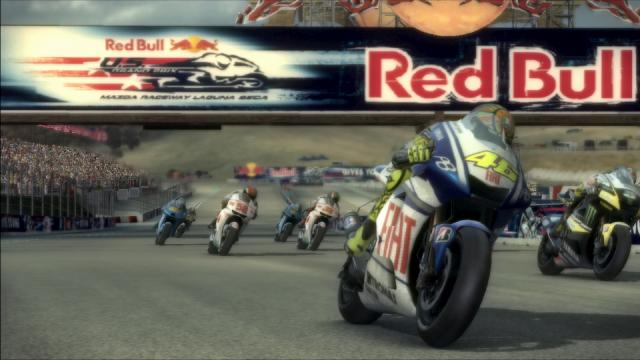
MotoGP games are a perfect example of just why you shouldn’t judge a game from your first hour of playing it. Bike racers like this that lean closer to the simulation end of the spectrum offer up a vicious learning curve to those who feel more at ease on 4 wheels, and if you think you’ve got what it takes after riding around Paradise City or taking to the dirt in MX vs ATV then you’ve got a shock coming.
The thing to remember when trying to get to grips with MotoGP 10/11 is that riding a motorbike at speed is very different to driving a car. Sit in a high powered Audi and turn into a corner slightly late and you end up running a bit wide; do the same on a beefed up Ducati and you’ll end up struggling through the gravel. Similarly carrying too much speed through a corner will slide a car off the track, but send a biker flying through the air while trying to remember if their medical insurance is up to date. Playing MotoGP gives the same essence of challenge and danger, and demands the same pinpoint accuracy. It sounds like something that would add up to being almost as fun as sandpapering your own kneecaps, but despite the frustrations stick with it and you’ll find some decent racing to be had.
The main bulk of MotoGP 10/11 is the career mode. You’ll start with a relatively weedy 125cc bike in a new team – no sponsors, no staff, no repuation. As you progress through the first season you’ll be introduced to the ideas of managing your sponsorship deals, hiring and firing staff and researching improved parts for your bike. It’s set up really well – you never feel like you’re getting bogged down before you know what you’re doing, and even when you do need to start messing with your team’s management it’s a fairly streamlined experience so you can stay focused on the racing. As you gain experience and reputation you’ll be able to take on better staff, more high-profile sponsors that pay higher rewards, and eventually start to work your way up to the more powerful MotoGP bikes that you’re used to the likes of Rossi and Lorenzo.
Race weekends are well accounted for, offering a practice session to get used to the track and tweak any bike settings you need from a comprehensive set of options. Following that you have the usual qualifying and race options, each offering a sensible challenge that means it’s never a straightforward task getting to the front. In fact the guy who talks you through your career (who incidentally lacks any clear interest or passion) tells you in your first few races that a top 10 finish is a good achievement. While you’re getting used to the handling that’s certainly true, but once you get used to the early turn-ins and slow direction changes that these machines offer you’ll be able to put more speed into the bends and challenge for top honors more often.
The control you have over your rider is as tight and responsive as realism will allow; get the hang of the slower turning mechanics and you’ll be stringing corners together like a pro, partly helped by the decent amount of riding assists available. Heavyweight bikes never stop feeling overly heavy though, something which might please purists but frustrate the rest of the gaming world as they do battle with what feels like 2 tonnes of bike beneath them. It’s difficult to judge whether this is poor handling or just outright realism – I’m not a biker in the real world – but either way it’s possibly slightly ill-judged for making a game accessible.

But that aside the racing is pretty decent, and as you ride you get rewarded reputation for doing things well such as completing clean sectors or overtaking other riders, but bad stuff like falling off or colliding with another rider will knock points off. It’s a good idea, but you’ll end up colliding with other riders through no fault of your own and getting penalised which can be annoying. This all helps to build your career and build up to the bigger teams, yet after a few hours everything starts to feel a little sterile and samey. There’s little to keep you coming back, and even the draw of the better machinery fades after a few hours. A small saving grace is the drop-in/drop-out split screen co-op option, allowing both of you to race for the same team. It’s great to see local multiplayer represented like this (there’s really not enough of it around) but in tight races where a wide view is vital to pick your corner apexes it can also be a little off-putting.
Away from the career mode you’ve got a fair few options to keep you occupied a little longer. The obligatory online modes are up for the taking, and racing against a few mates certainly sparks up some more fun competition. You’ve also got the World Championship mode, letting you complete entire seasons without the extra burden of managing your team; a Career Mode Lite if you prefer. Time trials are also included, as is a challenge mode which puts you up against the clock and rewards your precise driving with extra precious seconds needed to complete the race without losing any “lives”. Getting through an entire championship in this mode is quite a hefty challenge and I found myself gravitating more towards this than the career mode.
MotoGP 10/11 is a tricky game to judge. The learning curve will destroy the fun for some, and for many others the lardy high-end bikes will disappoint. But there’s no denying that when it clicks, it clicks and if this happens for you then you’ll have plenty to keep you going. Biking nuts will appreciate the career mode more than your average Joe with all of its tinkering, updating and working through the ranks, and anyone who really enjoys MotoGP as a sport will be more than willing to put the time into learning the ropes. Those of you who fit into these categories are the lucky ones and will really enjoy yourselves, especially with the game already receiving a price cut, but there’s no denying this isn’t for anyone after a quick fix.
 |

Leave a Reply